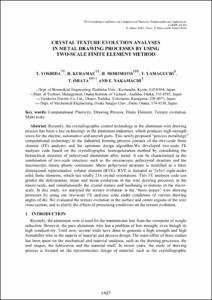Mostra el registre d'ítem simple
Crystal texture evolution analyses in metal drawing processes by using two-scale finite element method
| dc.contributor.author | Yoshida, T. |
| dc.contributor.author | Kuramae, H. |
| dc.contributor.author | Morimoto, H. |
| dc.contributor.author | Yamaguchi, T. |
| dc.contributor.author | Ohata, T. |
| dc.contributor.author | Nakamachi, E. |
| dc.date.accessioned | 2020-04-15T10:54:55Z |
| dc.date.available | 2020-04-15T10:54:55Z |
| dc.date.issued | 2013 |
| dc.identifier.isbn | 978-84-941531-5-0 |
| dc.identifier.uri | http://hdl.handle.net/2117/183444 |
| dc.description.abstract | Recently, the crystallographic control technology in the aluminum wire drawing process has been a key technology in the aluminum industries, which produces high-strength wires for the electric, automotive and aircraft parts. This newly proposed “process metallurgy” computational technology in the industrial forming process consists of the two-scale finite element (FE) analyses and the optimum design algorithm.We developed two-scale FE analyses code based on the crystallographic homogenization method by considering the hierarchical structure of polycrystal aluminium alloy metal. It can be characterized as the combination of two-scale structure, such as the microscopic polycrystal structure and the macroscopic elastic plastic continuum. Micro polycrystal structure is modelled as a three dimensional representative volume element (RVE). RVE is featured as 3x3x3 eight-nodes solid finite elements, which has totally 216 crystal orientations. This FE analyses code can predict the deformation, strain and stress evolutions in the wire drawing processes in the macro-scale, and simultaneously the crystal texture and hardening evolutions in the micro-scale. In this study, we analyzed the texture evolution in the “three passes” wire drawing processes by using our two-scale FE analyses code under conditions of various drawing angles of die. We evaluated the texture evolution in the surface and center regions of the wire cross section, and to clarify the effects of processing conditions on the texture evolution. |
| dc.format.extent | 9 p. |
| dc.language.iso | eng |
| dc.publisher | CIMNE |
| dc.rights | Open Access |
| dc.subject | Àrees temàtiques de la UPC::Matemàtiques i estadística::Anàlisi numèrica::Mètodes en elements finits |
| dc.subject.lcsh | Finite element method |
| dc.subject.lcsh | Plasticity -- Mathematical models |
| dc.subject.lcsh | Plasticity |
| dc.subject.other | Computational Plasticity, Drawing Process, Finite Element, Texture evolution, Multi scale |
| dc.title | Crystal texture evolution analyses in metal drawing processes by using two-scale finite element method |
| dc.type | Conference report |
| dc.subject.lemac | Elements finits, Mètode dels |
| dc.subject.lemac | Plasticitat -- Models matemàtics |
| dc.subject.lemac | Plasticitat |
| dc.rights.access | Open Access |
| local.citation.contributor | COMPLAS XII |
| local.citation.publicationName | COMPLAS XII : proceedings of the XII International Conference on Computational Plasticity : fundamentals and applications |
| local.citation.startingPage | 1427 |
| local.citation.endingPage | 1435 |


